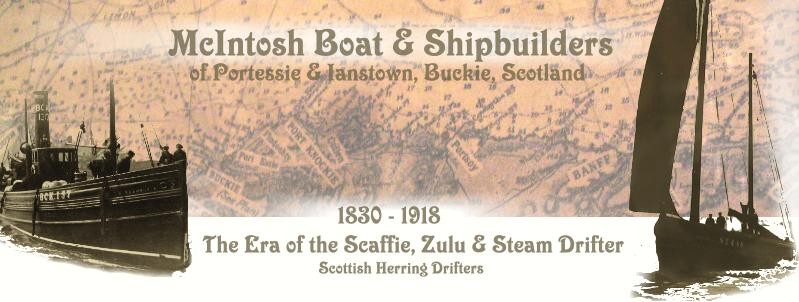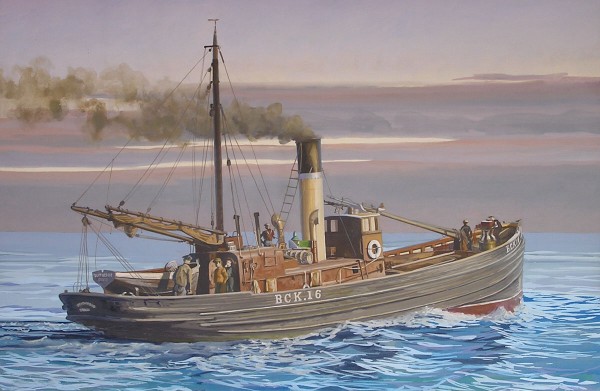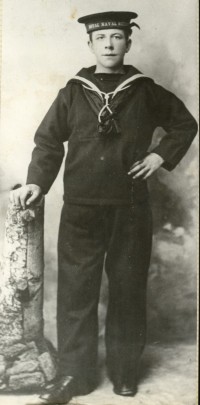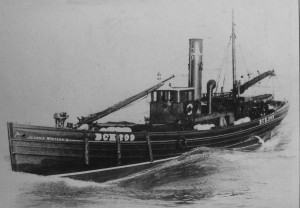
View this page at 1024x768 This page last updated March 2008. Please contact me for comment or if you can help with extra information.
NEW Check out the EXCELLENT collection of steam drifter photos contributed by ally & other contributors on the trawlerphotos website HERE
The reference book for all Buckie based Steam Drifters is 'Steam Drifters Recalled' Portgordon to Portsoy. All of the McIntosh built Steam Drifters are covered in this publication, except for three. BF 343 Silverscale (Macduff), ? Eliza F. Craig (Aberdeen) & INS 372 Holme Rose (Inverness). This makes the total number launched to twenty.
More information on the gouache ('a kind of water colour that dries looking like chalk') paintings by Rob Andrew shown opposite & below.
Find out more about
And also the Mesothelioma Fund
|
A further nineteen were launched, the last being the Jeannie McIntosh BCK 209 which was launched in February 1915. 
A photograph of the McIntosh built Bramble BCK 137 launched in April 1908, was used as the basis for the Steam Drifter depicted on the mural overlooking the beach at Cullen. NEW - April 2007
|

BCK.16 Blythesome
|
The 'Frigate Bird' at Buckie 'Her hull is substantially built of wood , but all the deckhouses are of iron. Her engines are of the compound surface condensing type, 45hp with 20" cylinders. Her trial trip took place on Friday, ten miles out from Aberdeen & back. She gave the highest satisfaction, the engines developing ten knots. The boiler is of the ordinary marine type, with two furnaces. There is a handy donkey engine for pumping etc., & forward is fitted a powerful Beccles winch which is supplied with steam from the same boiler, which works up to 130lbs of steam pressure. In the bunkers there are 40 tons of coal, sufficient at 8 tons per week to carry the vessel for the next five weeks.' |
First Buckie built Steam Drifter? Click the pic for more info. |
However she was still a 80ft carvel planked timber vessel designed to catch herring. She could now shun certain adverse winds & not only put in more fishing time than the Zulu, but in most cases get the catch back to the market much sooner. This came at a cost however, as the steam drifter was not only much more expensive to purchase, she was much more expensive to operate. They gave the fishermen the means of catching much more herring, which they did - but then they needed to. They were now also dependent on a regular supply of coal. The change from sail to steampower required a huge increase in investment as a new boat was required, but another option was becoming available to the fishermen. Small paraffin fueled motors such as Kelvins & Gardners began to be installed in the sailboats, mainly as auxiliaries because of their low power. It was not until around 1917 that motors were available that could power the sailboats to anywhere like the speed of the steam drifter. Lets not forget some fishermen such as Alexander 'Sandy' MacLeod of Stornoway, fished his Muirneag continuously until 1939, refusing to fit an engine. Fishing methods remained basically the same, except nets were now hauled over the bow to prevent them fouling the propeller, thus the steam winch was now positioned on the starboard bow. Most things remained the same however - it was still hard, sometimes dangerous work & less dependence on the weather meant more time out fishing. Sails & nets still needed barking (tanning) regularly, & were still dried at every opportunity to combat rotting. A dinghy was now included & in many cases saved the crew from almost certainly drowning - as in the sinking of Frigate Bird in 1904. |
in his short story 'Calcium Carbide'. "Lugs wis come o' a famous fisher faimly (fae Finechty). In fact his Granda scored a great victory ower the Aul Enemy at Yarmouth. Granda wis skipper o' a Zulu boat that had jist left Yarmouth River fin the win' fell flat calm, an' the rain came doon in buckets - jist hale watter! The hale crew disappeared below, leavin' Granda sittin' like a prize doo at the helm. Sail boats had nae wheelhooses, so Granda jist had t' tak' 'is shak' wi' the wither.
|
|
16 inch triple expansion engine by Clyne & Mitchell of Aberdeen - 37hp The concept of the boiler & steam engine powering the 'Frigate Bird' had been well tried and proven by 1900 & an engine of similar specifications was fitted to their last steam drifter launched in 1915.
|

George Flett of Findochty in his Royal Naval Reserve uniform. |
At the outbreak of war, the Steam Drifters were required to return to their home ports, where they were requisitioned by the Admiralty for war service, & given a Pennant Number. Where the boat went, the crew went, & they became part of the Royal Naval Reserve. The port fishing number was replaced with the letters HMD (His Majesty's Drifter), but in most cases the name remained unchanged.
|
|
While they were very efficient at catching herring, they had become too expensive to operate in comparison with the new motor fishing boats. The new much improved motors developed during the carnage of WW1, could provide similar power at much less cost to purchase and operate. These motors could be run & maintained by a crew member, thus saving the wages of the engineer & stoker. They were also not reliant on large quantities of coal which was becoming more expensive. The efficient catching power of the Steam Drifters had maybe begun to thin the herring stocks, & the catches began to drop. However, they could still be a viable fishing boat, & many continued to fish through the 1920's, with their numbers declining into the 1930's as did the herring fishery. As mentioned, the Jeannie McIntosh saw service in WW2, and continued as a work vessel until 1947. |

BCK 209 Jeannie McIntosh |
|
Mr. Ron Stewart "Sail & Steam" Moray District Library Buckie District Fishing Heritage Museum Banffshire Advertiser "Steam Drifters Recalled - Portgordon to Portsoy" Mr. Andy Adams, Harwich Mr. David Mallinson - Mariners list, Rootsweb Mr. George Bergius (online resource) Rob Andrew - marine artist McIntosh family history sources |